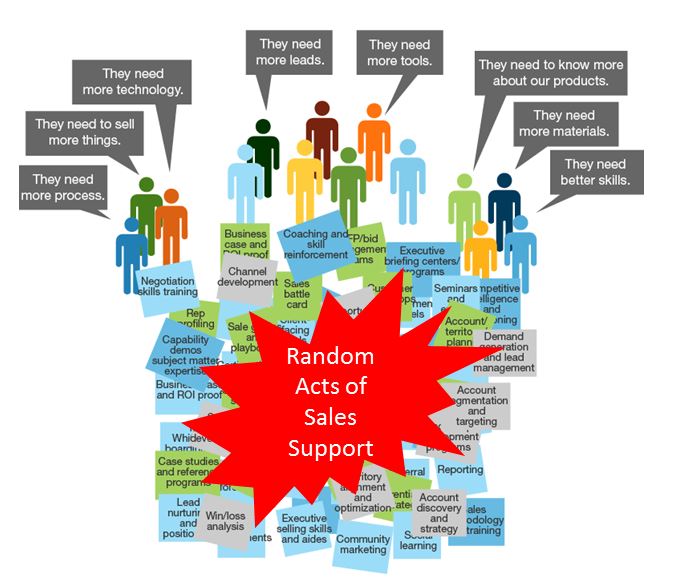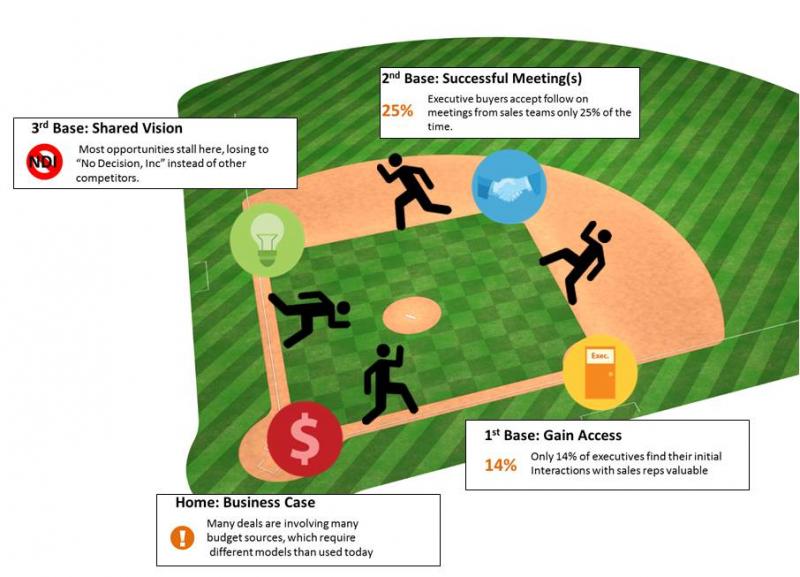Stealing Ideas from Baseball to Change the Game of Sales Enablement
I’ve been covering the sales enablement space here at Forrester for six years. While the concept is certainly more common than it was “back in the day”, I’m not really sure we as a community have a lot of clarity about how to get various Marketing, Human Resources, IT, Finance, and Sales groups on the requisite same page required to drive the desired effectiveness and efficiencies of most sales enablement initiatives across the selling system.
The problem today? Sales is Getting Too Much Well Intended Help and Not Enough Real Support
One of the important realizations that we continue to illuminate for business leaders is that when all of these groups are working independently to support sales, a tremendous amount of uncoordinated, redundant, or conflicting investments are made. Corralling these “random acts of sales support” is job #1 of any strategic sales enablement initiative…but how do you determine whose efforts are the random ones? Whether you are in a small or large organization there are many different people are certain they know what salespeople need to be successful, resulting in an avalanche of sales enablement deliverables, but few real results.

I recently published a report entitled “Using Selling Objectives to Corral Random Acts of Sales Support” that I wrote based on a lot of hard work with well-known organizations implementing strategic sales enablement functions. After fitting in all of the key principles and arming you with tried and true ways to anticipate and avoid common and knowable pitfalls, the report ended up being quite comprehensive. As complicated as it can be to navigate your internal organization, the core idea behind the report is quite simple – organize and measure your sales enablement efforts around four (4) common sales objectives: gaining access, having successful meetings, creating a shared vision of success, and developing a business case. Certainly not rocket science. We’ve learned the hard way that simplicity is frequently met with scrutiny and skepticism. The report goes in depth into the core principles behind the four sales objectives to abate scrutiny and provides tactics my clients and I have personally used to overcome the most common barriers to getting these ideas into the bloodstream of their organizations.
How are Sales and Baseball So Alike?
One of my favorite movies is Moneyball. In that film, Billy Beane (Brad Pitt) tells one of his players “I pay you to get on to first base, not to get thrown out at second.” Why was that idea of getting on base – and isolating the formula and formation of individual players to achieve that simple objective – so important? Because at the end of the day, the teams with the most runs win games and the teams who get the most runners on base score the most runs. Beane knew that focusing on runs was the paramount priority, and everything else was of secondary importance.
If you look closely, most sales organizations are unconsciously following the model Beane fought against. When we examine most sales organizations the same pattern emerges. It’s only about 20% of the sales force that is: driving the bulk of your new revenues, cross selling the bulk of your products, or selling your new products or services. Just like were not a lot of “Jason Giabambis” out there who could play first base – there are not enough of those 20% sellers to go around.
Rethinking How to Support Your Sales Force
When you stop thinking about “sales” as a monolithic group of people, a transaction to be made, or an assembly line of tasks to be automated – and start thinking about it as a dynamic business process, you will start to see a lot of similarities between the vision of baseball articulated in Moneyball and a methodical, systematic way to improve the productivity of your sales force.

Regardless, if your focus is transactional and volume-based, or consultative and results-based, sales people must still accomplish the same set of basic objectives. Just as baseball players must round all of the bases to score, all sales people must: get access to the right people, have successful meetings, create a shared vision with the buyer about the perception of value, and develop business case to close the business.
Just like in baseball, advancing runners (opportunities) into scoring position (predictable pipeline stages) may seem like a simple task, but in practice there are many factors at play. Athletes study game films, practice, train constantly, and adopt rigorous health regimens – all so we can cheer a “successful” batter who hits .300 (or in other words – a batter who actually fails to get a hit 7 out of 10 times).
The genius of Billy Beane’s concept in Moneyball was to look at the entire sport through a different lens.
Why not also look at enabling your sales force through a different lens?
The sales process is a lot more like a sport than an assembly line because the end prize (signing a contract) is more subjective than most business leaders would like to believe. In the graphic above, you can clearly see common challenges your sales people face just getting on to first base with an executive buyer. All things being equal, if you only improved your on base percentages (getting more meetings with specific executive buyers) you will inevitably score more runs. Imagine, if you looked at sales enablement holistically like a baseball manager – and invested effort to make incremental improvements in the conversion rates for each stage? The impact becomes multiplicative.
It’s a simple concept. Our clients who’ve implemented it actually refer to the concept as “radical simplicity”.
It works.
Unfortunately, overcoming the internal organizational resistance requires preparation, diligence, and persistence. That’s the purpose of the report – to provide you with the rigor, internal messaging, pictures, concepts, and tips you will need to start simplifying your selling system.